New research from the University of Illinois Urbana-Champaign has made it possible to create flexible screens that can change color, convey information, and even transmit covert messages using infrared light.
 University of Illinois Urbana-Champaign engineers have developed a new breed of display screens that use flexible fins, varying temperatures, and liquid droplets that can be arranged in various orientations to create images. The control is precise enough to achieve complex motions, like simulating the opening of a flower bloom. Image Credit: Sameh Tawfick
University of Illinois Urbana-Champaign engineers have developed a new breed of display screens that use flexible fins, varying temperatures, and liquid droplets that can be arranged in various orientations to create images. The control is precise enough to achieve complex motions, like simulating the opening of a flower bloom. Image Credit: Sameh Tawfick
Engineers have used capillary-controlled robotic flapping fins to construct switchable optical and infrared light multipixel displays that are 1,000 times more energy efficient than light-emitting devices. They were inspired by the changing skin of animals like chameleons and octopuses.
The latest research, conducted by Sameh Tawfick, Professor of Mechanical Science and Engineering, shows how fluids and flexible fins can concurrently transition between straight and bent as well as hot and cold by adjusting the volume and temperature of tiny fluid-filled pixels.
The flaps can flip in different directions, resembling old-fashioned flip clocks, by changing the volume of fluids inside the pixels, and by changing temperature, the pixels can interact with one another via infrared energy.
The journal Science Advances published the study’s findings.
Tawfick’s study on soft robotic displays at Illinois was sparked by his interest in the interaction of elastic and capillary forces, or elasto-capillarity, which he first developed as a graduate student.
An everyday example of elasto-capillarity is what happens to our hair when we get in the shower. When our hair gets wet, it sticks together and bends or bundles as capillary forces are applied and released when it dries out.
Sameh Tawfick, Professor, Mechanical Science and Engineering, University of Illinois Urbana-Champaign
The researchers developed tiny containers, or pixels, in the lab that are a few millimeters in size and include fins made of a flexible polymer that bend when the pixels are loaded with fluid and drained using a network of tiny pumps. According to Tawfick, the pixels can have one or more fins and are organized into arrays to create a display.
Tawfick added, “We are not limited to cubic pixel boxes, either. The fins can be arranged in various orientations to create different images, even along curved surfaces. The control is precise enough to achieve complex motions, like simulating the opening of a flower bloom.”
According to the study, another aspect of the new displays is their capacity to transmit two signals at once, one of which can be seen by the human eye and the other of which can only be viewed by an infrared camera.
“Because we can control the temperature of these individual droplets, we can display messages that can only be seen using an infrared device. Or we can send two different messages at the same time,” Tawfick further stated.
The new displays do have certain restrictions, though, according to Tawfick.
The researchers discovered while creating the new gadgets that the tiny pumps required to manage the pixel fluids were not readily available in the marketplace and that the entire system is sensitive to gravity, meaning that it only functions when it is horizontal.
Tawfick noted, “Once we turn the display by 90 degrees, the performance is greatly degraded, which is detrimental to applications like billboards and other signs intended for the public. The good news is, we know that when liquid droplets become small enough, they become insensitive to gravity, like when you see a rain droplet sticking on your window and it doesn’t fall. We have found that if we use fluid droplets that are five times smaller, gravity will no longer be an issue.”
According to the scientists, the focus of their further application of the developing technology will be on the well-understood science of how gravity affects droplets.
Tawfick stated that he is particularly interested in where this technology is going because it introduces a novel concept to a sizable market for huge reflective screens.
Tawfick concluded, “We have developed a whole new breed of displays that require minimal energy, are scalable and even flexible enough to be placed onto curved surfaces.”
Additionally involved in this study were researchers from the University of Illinois, Jonghyun Ha, Yun Seong Kim, Chengzhang Li, Jonghyun Hwang, Sze Chai Leung, and Ryan Siu.
This study was funded by the National Science Foundation and the Air Force Office of Scientific Research.
Flapping fins driven by capillarity and hydrodynamics - bimorphic single-fin display pixel
Video Credit: University of Illinois Urbana-Champaign
Journal Reference:
Ha, J., et al. (2023) Polymorphic display and texture integrated systems controlled by capillarity. Science Advances. doi:10.1126/sciadv.adh1321.